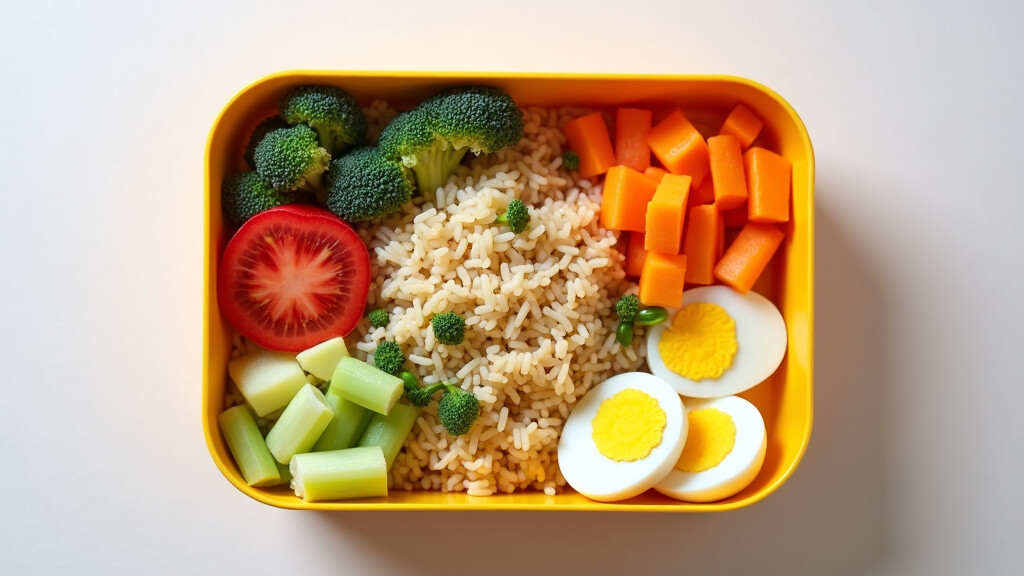
Bringing homemade lunches to work has saved me money and helped me eat better overall. The right lunchbox meal can turn a dull workday into something to look forward to. If you’re looking to trim food costs, eat well, and keep things simple, I’ve put together some ideas and strategies that have worked for me when building budget-friendly lunches for work.
Why Packing Lunch for Work Makes Sense
Bringing your lunch from home instead of eating out is an easy way to manage your budget and your diet. The cost of buying lunch daily can add up quickly. Buying lunch at work even twice a week can total up to several hundred dollars a year. By packing my own food, I’ve found that I eat healthier and feel more satisfied thanks to fresher, better balanced meals.
This is just as true for those who work from home, or run a home-based business. If you’re ordering delivery from home when you have food in the fridge, you’re spending way more than you have to. No matter how busy you are, it doesn’t take long to prepare a fresh meal from what you have available.
Many lunchbox ideas require only basic kitchen tools and standard groceries, so special equipment usually isn’t required. Focusing on a mix of protein, grains, vegetables, and fruit also gives me plenty of variety without overspending. Plus, making my own lunch gives me better control over portion size and flavor.
Homemade lunches also help cut back on unnecessary packaging waste from takeout containers. By bringing reusable containers, I’m making choices that are easier on the environment as well as on my wallet, which is a win-win situation.
Budget-Friendly Ingredients to Keep on Hand
Some ingredients always make my shopping list because they are affordable, versatile, and last well in the fridge or pantry. These staples help me pull together quick, satisfying lunches even when I’m pressed for time.
- Eggs: Hardboiled eggs add protein to salads, sandwiches, or rice bowls.
- Beans and Lentils: Canned or dried, they’re always handy for salads or hot dishes.
- Rice and Pasta: These are filling, cheap, and work with lots of toppings.
- Rotisserie Chicken or Canned Tuna: Useful for wraps, sandwiches, or tossed in salads.
- Frozen Vegetables: They’re ready to go in stir-fries or soup without waste.
- Oats: Overnight oats or savory oat bowls travel well and are wallet-friendly.
Additional staple ingredients that help make budget meals exciting include things like whole wheat tortillas, cabbage, seasonal fruit, and sauces like soy sauce or salsa. I also keep basic pantry seasonings such as garlic powder, dried herbs, and chili flakes, which are inexpensive but change up the flavors with minimal effort.
Easy and Affordable Lunchbox Ideas
When I plan lunches, I use basic recipes and adjust with whatever leftovers or deals I find at the store. Here are a few reliable lunchbox ideas that help me keep costs low and meals interesting.
- DIY Grain Bowls: Start with rice, quinoa, or barley. Add chopped veggies, beans, and a simple homemade dressing. If I have roasted chicken or leftover tofu, I add that too.
- Wraps and Burritos: A tortilla, some cooked beans, shredded cheese, and salsa make a filling meal. I often add spinach or grilled peppers for color and flavor.
- Pasta Salad: Cold pasta combined with chopped vegetables, a protein like tuna or a sliced egg, and an olive oil based dressing always packs well.
- Vegetable Fried Rice: Leftover rice, some scrambled egg, frozen peas, and carrots with soy sauce can be made in minutes.
- Soup in a Thermos: When it’s cold, I make a big batch of soup with lentils, vegetables, and whatever meat I have. A thermos keeps it hot till lunch.
- Overnight Oats: Oats, milk, yogurt, fruit, and a drizzle of honey make a filling, portable meal. Works for breakfast or lunch.
- Bento-style Lunchbox: I arrange boiled eggs, veggies, fruit, crackers, and hummus in sections for a finger-food lunch that feels special without much work.
Other easy lunches include leftovers from dinner repurposed with a new twist, veggie quesadillas using grated cheese and inexpensive vegetables, or hearty vegetable sandwiches using affordable homemade spreads like hummus. The possibilities really stretch with a bit of imagination and whatever is handy in your pantry.
Planning Ahead for Success
Batch cooking helps me avoid the temptation to order lunch, especially when work gets busy. I spend a bit of time on Sunday prepping proteins, washing veggies, cooking grains, and portioning out fruit. Storing lunchboxes in the fridge means I can just grab and go every morning.
Mixing up flavor profiles throughout the week also makes leftovers more appealing. I might use roast chicken in a salad one day, and then add it to a wrap with barbecue sauce the next. Building in this variety helps fight lunch boredom.
Prepping sauces, dressings, or dips on the weekend goes a long way toward keeping things quick and tasty. I mix up a simple vinaigrette, spicy yogurt dip, or garlicky hummus to have options ready and change the flavor of lunches in a snap.
Smart Shopping Tips for Budget Lunches
I always look for sales and discounts on proteins like chicken, or stock up on dry goods in bulk. Choosing store brands rather than name brands also stretches my dollar further. When I have time, I cook big batches of beans and rice from scratch instead of buying canned versions.
- Check the unit price: Bigger packages usually save me money when I compare price per ounce or pound.
- Shop produce in season: Fruits and vegetables are less expensive when they’re in season. I use frozen produce if fresh is too pricey.
- Plan meals around specials: Weekly grocery flyers help me pick out budget-friendly proteins and sides for the week.
Sometimes, I hit up local produce markets or discount grocery stores to find better prices on fresh fruits and vegetables. I also make a loose meal plan based on what I already have in my kitchen to cut impulse purchases at the store, keeping my grocery bills steady. Planning around leftovers also plays a big part. For example, a large batch of brown rice on Monday can pop up again as fried rice or in a rice salad later in the week.
Food Safety and Packing Tips
Keeping food fresh and safe is really important, especially when packing in advance. I use an insulated lunch bag with an ice pack for anything that should be cold. Soups or hot meals go in a thermos. Silicone or reusable containers make it easy to reheat food at work if needed.
I also try to avoid highly perishable ingredients like mayonnaise when the lunchbox will be out all morning, or I pack the sauce separately in a small container.
Labeling containers with the date is helpful when prepping several days ahead, so I don’t forget what was packed first. Paying attention to use-by dates of proteins and cooked grains makes sure everything stays safe and tasty. I also do a quick check each night before bed to confirm tomorrow’s lunch is ready to go, which saves time and ensures nothing gets missed.
Making Your Lunches More Interesting
One thing I’ve learned is that a little creativity goes a long way. Adding different textures, pops of color, or a simple dipping sauce makes an ordinary meal nicer to eat. Sometimes I’ll add pickled vegetables, olives, nuts, or seeds for extra flavor. Using herbs or a squeeze of lemon brightens up leftovers that might taste plain otherwise.
Trying foods from other cuisines, like using curry powder for rice or making Greek salad with feta and olives, keeps my lunches from feeling repetitive. Leftovers from dinner often work well with just a few tweaks.
I like to experiment with new spices and global flavors. A spoonful of kimchi, a dusting of za’atar, or some chili crisp can turn a basic rice bowl or sandwich into something with a lot more excitement. Even tossing in something as simple as a handful of raisins or sliced almonds can change the texture and taste completely.
Common Pitfalls and How to Avoid Them
I’ve made a few mistakes along the way, so I always keep a few things in mind. Packing too early in the week with delicate greens often means soggy salads. Now, I pack lettuce and toppings separately and assemble right before eating. If I get tired of the same thing over and over, I look for new recipes or search for lunchbox ideas online to get fresh inspiration.
- Portion size: I make sure to pack enough food. It’s easy to under-pack and end up hungry, which makes vending machine snacks tempting later.
- Keeping things fresh: Storing crunchy toppings (like croutons or nuts) separately avoids them getting soggy.
- Preventing waste: I rotate what I buy so nothing sits in the fridge too long and goes bad.
Finding balance in flavor and nutrition matters too. Sometimes I catch myself packing only carbs or skipping vegetables altogether, so I try to build meals using a colorful selection of ingredients to keep things balanced and visually inviting.
Frequently Asked Questions
Question: What’s the best way to start meal prepping for work lunches?
Answer: I start simple. Cooking extra portions when I make dinner and setting aside lunches in containers saves lots of time. Focusing on a main grain, a protein, and a couple of vegetables builds a balanced, filling meal.
Question: Are there any lunchboxes that work better for packing on a budget?
Answer: I use a basic, reusable container set with divided sections and an insulated tote bag. Bento-style boxes keep different foods separate without needing extra packaging, which saves money and keeps food looking appetizing.
Question: How can I keep lunch interesting without spending more?
Answer: Switching up sauces and seasonings brings new flavors to simple foods. I swap out proteins, add fresh herbs, and try different textures to keep meals exciting without adding extra costs.
Getting the Most from Budget-Friendly Lunches
Bringing lunch to work has helped me stay on budget and improved my energy throughout the day. Rotating a few easy, affordable recipes, shopping with intention, and packing smartly have all paid off. With a little planning and creativity, great work lunches are within reach without stress or extra expense.
Trying out different combinations and building on what works best for my schedule and tastes has made lunch something I consistently look forward to, even on the busiest workdays. Lunch at work doesn’t need to be boring or expensive. Taking a small amount of time to prep and plan pays off with delicious results and lasting savings.

I appreciated how it emphasized variety without complicating things and mixing up flavors, using leftovers creatively, and prepping just once or twice a week. The ingredient staples and simple recipes were especially helpful for staying within a budget while still eating well. The section on food safety and storage tips was a great reminder, too.
Do you have a favorite go-to sauce or seasoning blend that helps bring leftover ingredients back to life?
Hello, Rob! Nothing specific, but I tend to like spicy flavors in my sauces and seasonings.
Mark